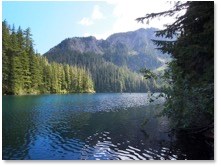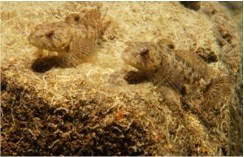Last updated: August 8, 2017
Article
Ecology of Introduced Prickly Sculpin in Lake George and Other Mountain Lakes of the Upper Nisqually River Basin

Introduction
Introduced fish species are common in freshwater ecosystems and may cause major ecological changes. Effects of diminutive species, such as freshwater sculpin, on the ecosystem may be largely unknown because they can be difficult to identify and are not a recreationally- or commercially-valuable species. Introduction of freshwater sculpins outside of their native range has occurred but the effects of these introductions are largely unknown. Prickly sculpin (Cottus asper) has been introduced in some mountain lakes of the upper Nisqually River basin including Lake George in Mount Rainier National Park. Because prickly sculpin are large (≥ 230 mm total length) relative to other sculpin species, they have the potential to consume a broader range of prey and therefore impact native fauna in non-native habitats. Prickly sculpin is common in lacustrine, estuarine, and riverine habitats in lowlands of the Pacific Northwest. Generally, they occupy lower elevations than other freshwater sculpin species.
Because most mountain lakes were historically fishless, native fauna may be especially vulnerable to predation by introduced fish. Sharp reductions of amphibian populations in mountain lakes of western United States are believed to be caused by fish introductions. Fish introductions have resulted in changes in nutrient cycles and primary production. Additionally, benthic macroinvertebrate and zooplankton communities appear to be restructured following fish introductions.
The objectives of this study were to document that prickly sculpin are still present in Lake George and collect some basic ecological information on this population and other populations in the upper Nisqually River basin. Additionally, we compared the diet, age, and behavior of the introduced mountain populations to native populations in two lowland lakes.

Status
We used baited minnow traps to collect prickly sculpin in September 2012. Besides Lake George, we also sampled Bertha Mae, Cora, and Granite lakes (Gifford-Pinochet National Forest) in the upper Nisqually River basin. For all four lakes, the only fish collected in the traps were prickly sculpin. In Lake George, a total of 76 sculpin were collected in the traps (nine traps set for three hours) and the largest sculpin was 139 mm in total length. For all four lakes, the largest sculpin collected was 215 mm. Preliminary analysis of the diet indicated that small sculpin (50-75 mm) consumed primarily zooplankton (mostly copepods), whereas larger sculpin (> 75 mm) consumed fingernail clams, other macroinvertebrates, and small sculpin as well as zooplankton.
Preliminary analysis of prickly sculpin age indicates their life span is much longer in the mountain lakes than in lowland lakes. The mountain lakes are generally colder than and not as productive as the lowland lakes and thus growth rates are much slower. Lastly, prickly sculpin in the mountain lakes appear to be more active during the day than in the lowland lakes. This is likely due to lower prey availability and/or lower predation risk.

Discussion
Based on the wide range of fish sizes and ages, prickly sculpin appear to have established a self-reproducing population in Lake George as well as the other three lakes. Good numbers of prickly sculpin are present in Lake George. The diet, age, and diel activity pattern of prickly sculpin in the mountain lakes appears to be quite different than in their native lowland lakes. This underscores their ability to adapt to new ecosystems and demonstrates their actual niche is much broader than what was expected. Because they are relatively abundant, consume a variety of prey types and sizes, and grow to a large size, they may have important effects on the ecosystem of Lake George and other mountain lakes.
Exactly how prickly sculpin were introduced into the mountain lakes is unclear; however, the introduction of prickly sculpin is something resource managers should be aware of and should take preventative steps to make sure it does not occur in other mountain lakes.
